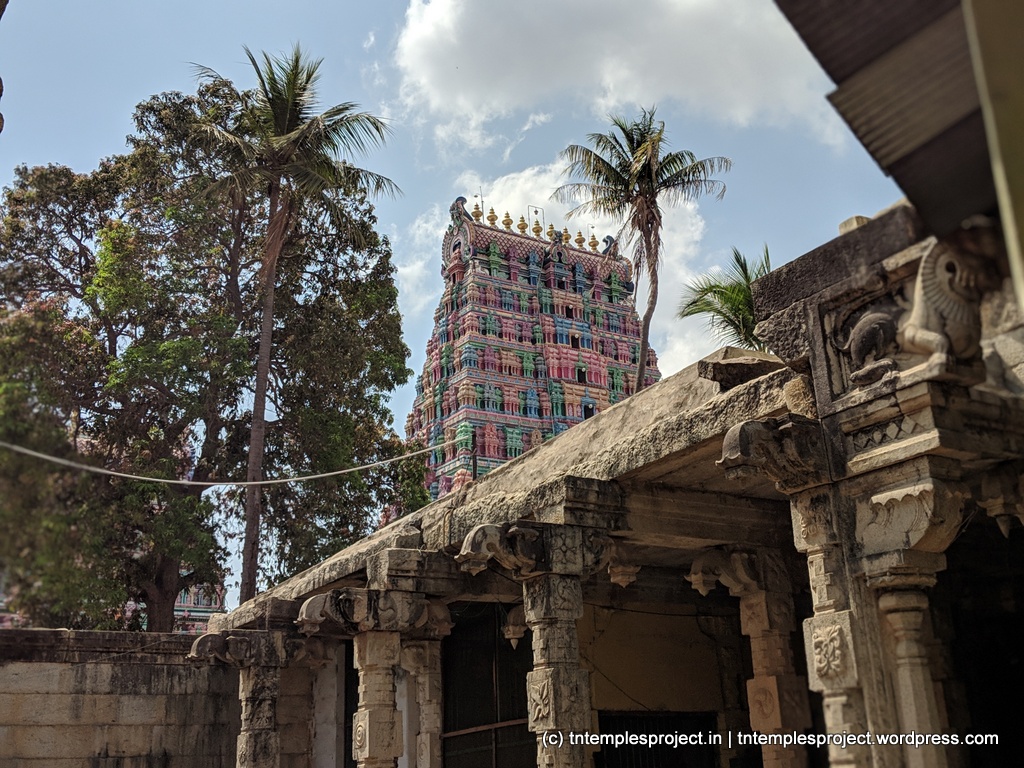Basic information about the temple
| Moolavar: | Swarna Kaleeswarar | Ambal / Thayar: | SorNavalli, Soundaranayaki, Meenakshi |
| Deity: | Siva | Historical name: | TirukkAnappaer |
| Vriksham: | Teertham: | Sivagangai, Yaanaimaduvu Teertham | |
| Agamam: | Age (years): | ||
| Timing: | to & to | Parikaram: | |
| Temple group: | Paadal Petra Sthalam (Pandya Naadu) | – | |
| Sung by: | Temple set: | ||
| Navagraham: | Nakshatram: | ||
| City / town: | Kalayar Kovil | District: | Sivaganga |
| Maps from (click): | Current location | Sivaganga (19 km) | Madurai (72 km) |
| Madurai (72 km) | Pudukottai (76 km) |
Location
Sthala puranam and temple information

This place has existed across the Satya Yugam, Treta Yugam, Dwapara Yugam and Kali Yugam, and has been known variously as Dakshina Kalipuram, Jothivanam, Manthara Vanam, Devadaruvanam, Bhuloka Kailasam, Makalapuram, Kanapperyil. In literature, the Sangam anthology Purananuru refers to this place as Tirukanapper.
The etymology of its present name is very interesting. When Sundarar was in Tiruchuli, he wanted to visit Kalayar Kovil as well. But when he came here, he understood that there were several Lingams under the ground, and didn’t want to trod on them as he went to the temple. Understanding his position, Siva took the form of a bull (kaalai in Tamil) and led the way through a path that had no Siva Lingams beneath it, and so the place is called Kalayar Kovil. (In a slight variation of this, another puranam suggests Nandi – also a bull – was deputed by Siva to lead Sundarar.)
This is an unusual Paadal Petra Sthalam, in that there are three sets of sub-temples within the temple complex – these are for Swarna Kaleeswarar & Swarnavalli, Someswarar & Soundaravalli, and Sundareswarar & Meenakshi. In ancient times, a Lingam appeared from the ground, and split into three, creating the three temples we see today. There are separate garbhagrihams for each of the three deities. Each of these is constructed and depicted as a separate temple, including their own bali peethams, dhwaja sthambams, nandis, etc.
Located in the heart of the Pandya country, Kalayar Kovil was once one of the seats of the Pandya rulers. This temple is associated with various Pandya kings, but the most important association is with the Marudhu brothers – Periya Marudhu and Chinna Marudhu – who ruled the region towards the end of the 18th century and fought against the British. In addition to being staunch devotees of Siva and great benefactors of this temple, the brothers also made significant endowments to the temple and surrounding villages. Therefore, in adherence to their wishes, a memorial for them is located on the street opposite the main gopuram. There are also life-sized idols of the two brothers inside the temple.

Swarna Kaleeswarar
A Pandya king had no children, so his queen made an image of a child out of gold, to pacify herself. Once, the king was traveling this way, and having heard of this temple, came here and prayed to Siva. After he and the queen took a bath in the temple tank, the golden image became a real child. Overjoyed by this, they built the temple for the Lord here, complete with a golden palliyarai (bed chamber) and a golden swing.
Someswarar
After being cursed by Sage Durvasa for trampling on a garland worn by Lakshmi, Airavata (Indra’s elephant) worshipped Siva at several places, including Siva as Someswarar here. Airavata also dug a tank with his tusks and used the water for his worship. The temple tank – called Yaanaimadu – supposedly never dries up.
Sundareswarar
The Pandya king Varaguna Pandyan lost his way back to Madurai, after a hunting expedition. He prayed to Siva and it is believed that Siva as Sundareswarar here led him to this temple, as a place of safety for the night, and also gave the king His vision. The king later built the temple around the moolasthanam, in remembrance of these events. The temple for Meenakshi-Sundareswarar is located between the shrines of Swarna Kaleeswarar and Swarnavalli Amman.
Arunagirinathar has sung on Murugan at this temple, in his Tiruppugazh.

The temple is essentially Pandya and built in the 7th century, though the core temple likely existed even prior to that. The Marudhu brothers expanded the temple during their time. It is said that on a clear day, one can sight the gopuram of the Meenakshi-Sundareswarar temple in Madurai, from the top of the Someswarar shrine. The inscriptions in the temple refer to various Pandya kings. The temple is also replete with excellent architecture from the Pandya period, and in particular, the various pillars inside the temple are exquisitely constructed and worked upon.
Other information for your visit
Contact
Phone: 04575-232516; 94862 12371
Gallery













































